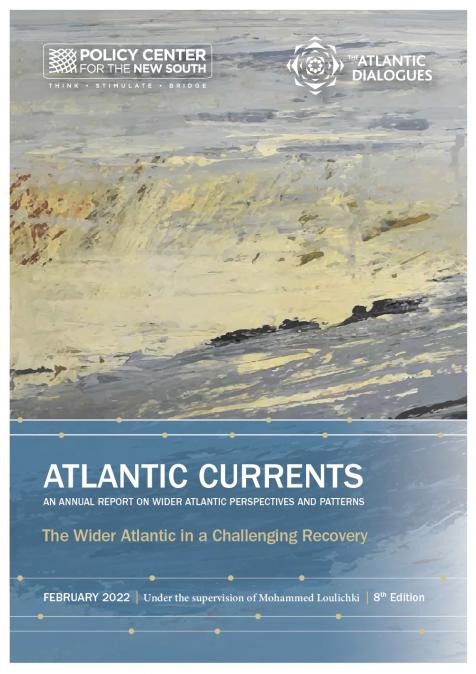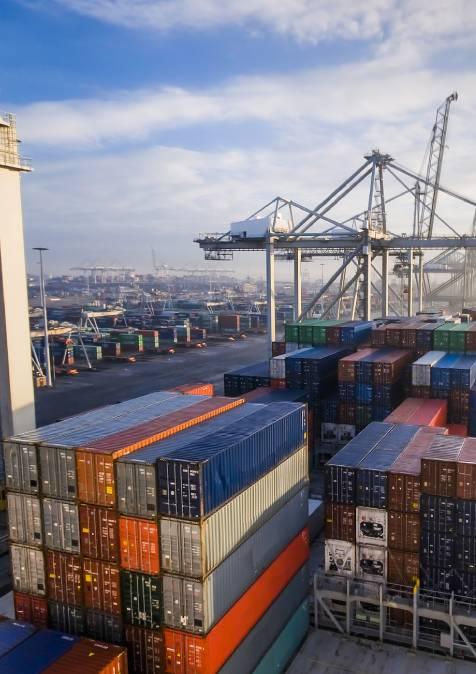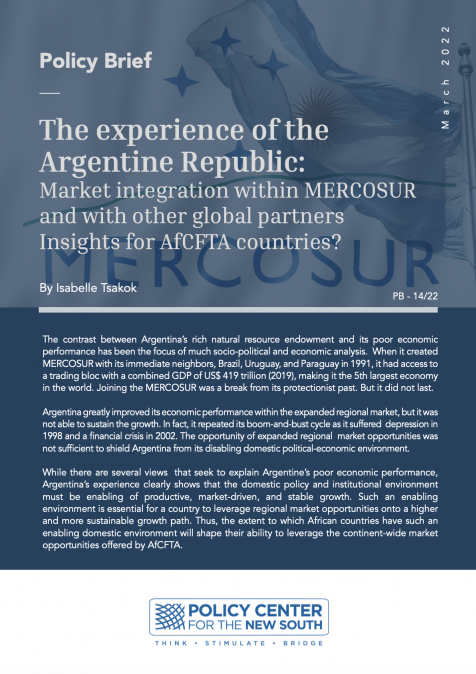Président
- Fathallah Oualalou, Senior Fellow, Policy Center for the New South (PCNS)
Introduction
- Kevin Cleaver, ancien vice-président associé, Fonds international de développement agricole (FIDA)
Intervenants
- Jennifer Blanke, Vice-présidente, Fondation Syngenta pour l'agriculture durable (SFSA)
- Bambang Brodjonegoro, président du conseil des commissaires, Bukalapak et PT Telkom
- Nguyen Minh Hang, vice-ministre des affaires étrangères, Vietnam
- Megumi Muto, vice-président de l'Agence japonaise de coopération internationale (JICA)
- Cecilia Nahón, directrice exécutive suppléante, Groupe de la Banque mondiale, Argentine
RELATED CONTENT
-
Otaviano Canuto & Helmut SorgeMarch 11, 2022Is Moscow really risking to be knocked to the floor, or can it land counterpunches? Will the removal of Russian banks from SWIFT, the international payment system, have the desired effect ...
-
March 10, 2022Africafé est une émission du Policy Center for the New South qui décrypte l’actualité des organisations africaines et de l’Afrique. A travers de courtes interviews, l’émission tente de proposer d’aborder de manière pédagogique les enjeux des organisations africaines et l’actualité du co...
-
AuthorsMarch 9, 2022S’il est commun de catégoriser les matières premières en fonction de leur réalité physique et de distinguer, en cela, produits agricoles, énergie et métaux, on se saurait oublier que ce sont les caractéristiques économiques qu’elles partagent qui justifient le regroupement de ces produits de base sous le terme commun de « commodities ». Une analyse en profondeur révèle toutefois la mise en œuvre, par les producteurs, de stratégies de différenciation par la qualité visa ...
-
AuthorsMarch 8, 2022The contrast between Argentina’s rich natural resource endowment and its poor economic performance has been the focus of much socio-political and economic analysis. When it created MERCOSUR with its immediate neighbors, Brazil, Uruguay, and Paraguay in 1991, it had access to a trading bloc with a combined GDP of US$ 419 trillion (2019), making it the 5th largest economy in the world. Joining the MERCOSUR was a break from its protectionist past. But it did not last. Argentina greatl ...
-
 AuthorsAlessandro Minuto-RizzoBernardo SorjFrannie LéautierIskander Erzini VernoitKassie FreemanNathalie DelapalmeJ. Peter PhamMarch 7, 2022The COVID-19 pandemic has had a huge impact on the global economy and has challenged the best minds to rethink how to design and implement an effective recovery. Countries in the wider Atlantic region have exhibited differential trajectories in traversing the pandemic. A number of countries in Europe succeeded in vaccinating most of their eligible populations, enabling life to return somewhat to normal. A smaller group of countries in Europe could manage infection rates even more ti ...
AuthorsAlessandro Minuto-RizzoBernardo SorjFrannie LéautierIskander Erzini VernoitKassie FreemanNathalie DelapalmeJ. Peter PhamMarch 7, 2022The COVID-19 pandemic has had a huge impact on the global economy and has challenged the best minds to rethink how to design and implement an effective recovery. Countries in the wider Atlantic region have exhibited differential trajectories in traversing the pandemic. A number of countries in Europe succeeded in vaccinating most of their eligible populations, enabling life to return somewhat to normal. A smaller group of countries in Europe could manage infection rates even more ti ... -
AuthorsMarch 4, 2022Le système monétaire international a connu de nombreuses crises. Celle consécutive à la dématérialisation régulière de la monnaie l'oblige à se reconstruire, suite au développement des crypto-monnaies et au succès du spéculatif et emblématique . Cette étude est, tout d'abord, consacrée à l'affaiblissement de ce système, avec une monnaie chinoise qui a choisi de ne plus s'y soumettre et des Etats qui dérogent à ses règles, comme le Monténégro, décidant unilaté ...
-
 AuthorsMarch 4, 2022The economic sanctions against Russia announced last week by the United States and Europe following the military invasion of Ukraine are having a profound impact on the Russian economy while also having repercussions at home. As in a boxing match, the expectation is that blows to the opponent can knock them out, despite the exposure on the punching side. The United States has applied some sectoral and limited economic sanctions against Russia since the annexation of Crimea in 2014 ...
AuthorsMarch 4, 2022The economic sanctions against Russia announced last week by the United States and Europe following the military invasion of Ukraine are having a profound impact on the Russian economy while also having repercussions at home. As in a boxing match, the expectation is that blows to the opponent can knock them out, despite the exposure on the punching side. The United States has applied some sectoral and limited economic sanctions against Russia since the annexation of Crimea in 2014 ... -
 AuthorsMarch 3, 2022مقال نشر للمرة الأولى على موقع بروجكت سيندكايت واشنطن - تُثير موجات نقص الإمدادات الناجمة عن اندلاع الجائحة المخاوف بشأن الأمن القومي في الاقتصادات المتقدمة. ونظرًا إلى شعورهم بالقلق إزاء الاعتماد المفرط على التصنيع الصيني، اقترحت كل من الولايات المتحدة والاتحاد الأوروبي واليابان مبادرات لنقل الإنتاج. وهم ليسوا بمفردهم. تكتسب عملية إضفاء الطابع الجيوسياسي على الصلة بين التجارة والصناعة والأمن المزيد من الزخم في العالم النامي أيضًا. ومن غرب البلقان إلى أمريكا اللاتينية، ترى الحكو ...
AuthorsMarch 3, 2022مقال نشر للمرة الأولى على موقع بروجكت سيندكايت واشنطن - تُثير موجات نقص الإمدادات الناجمة عن اندلاع الجائحة المخاوف بشأن الأمن القومي في الاقتصادات المتقدمة. ونظرًا إلى شعورهم بالقلق إزاء الاعتماد المفرط على التصنيع الصيني، اقترحت كل من الولايات المتحدة والاتحاد الأوروبي واليابان مبادرات لنقل الإنتاج. وهم ليسوا بمفردهم. تكتسب عملية إضفاء الطابع الجيوسياسي على الصلة بين التجارة والصناعة والأمن المزيد من الزخم في العالم النامي أيضًا. ومن غرب البلقان إلى أمريكا اللاتينية، ترى الحكو ... -
 AuthorsMarch 3, 2022This article was initially published on project-syndicate.org Supply shortages during the COVID-19 pandemic have set off a rush to reshore or nearshore production in the name of national security and resilience. But policymakers tasked with shaping new industrial policies should have no illusions that there are shortcuts to economic development. WASHINGTON, DC – Pandemic-induced supply shortages have heightened national security concerns in advanced economies. Worried about ove ...
AuthorsMarch 3, 2022This article was initially published on project-syndicate.org Supply shortages during the COVID-19 pandemic have set off a rush to reshore or nearshore production in the name of national security and resilience. But policymakers tasked with shaping new industrial policies should have no illusions that there are shortcuts to economic development. WASHINGTON, DC – Pandemic-induced supply shortages have heightened national security concerns in advanced economies. Worried about ove ... -
March 1, 2022يخصص مركز السياسات من أجل الجنوب الجديد حلقة برنامجه الأسبوعي "حديث الثلاثاء" لتقييم مخرجات القمة الاوروبية الافريقية ونموذج الشراكة الجديدة بين الطرفين، مع محمد لوليشكي، باحث بارز لدى مركز السياسات من أجل الجنوب الجديد. خلال القمة السادسة التي جمعت الاتحاديين في بروكسل وضع الاتحاد الأ...






